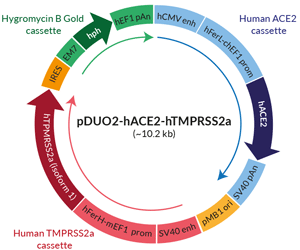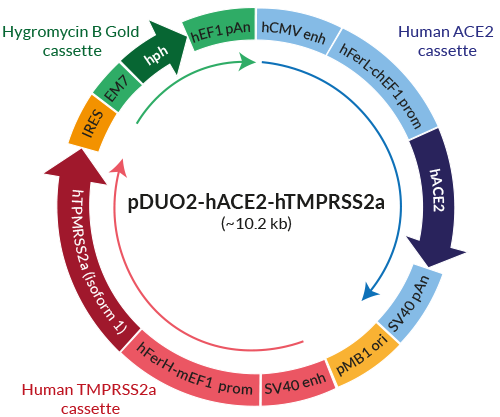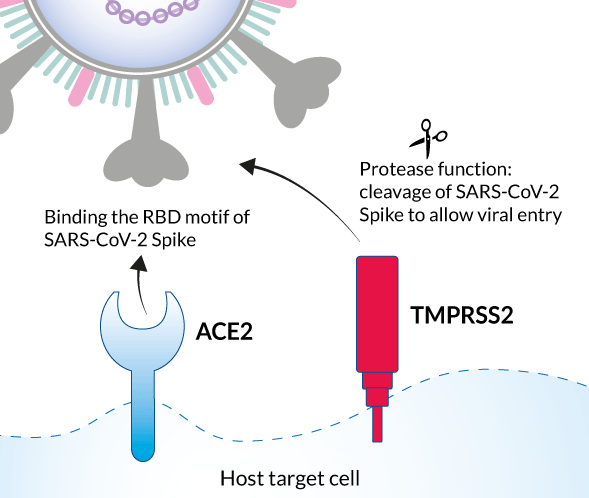Human ACE2 & TMPRSS2a Expression Vector
| Product | Unit size | Cat. code | Docs. | Qty. | Price | |
|---|---|---|---|---|---|---|
|
pDUO2-hACE2-TMPRSS2a Human ACE2 & TMPRSS2a genes |
Show product |
20 µg |
pduo2-hace2tpsa
|
|
Human ACE2 & TMPRSS2a coding sequences
GENES DESCRIPTION
Human ACE2 (angiotensin I-converting enzyme-2) is a type I surface transmembrane protein expressed in arteries, heart, kidneys, and epithelia of the lung and small intestine [1, 2]. It belongs to the angiotensin-converting enzyme family of dipeptidyl carboxydipeptidases [2, 3]. ACE2 is the cellular receptor of the Spike (S) protein of coronaviruses used for entry in host cells [4]. Recently, it was also found to be exploited by SARS-CoV-2 (or 2019-nCoV), the causative agent of COVID-19, to facilitate viral attachment to the surface of target cells [5-6]. (See Details for more information).
Human TMPRSS2a (transmembrane protease serine 2, isoform 1) is a multimeric protein containing four domains, among which a type II transmembrane domain and a serine protease domain. It is widely expressed in epithelial tissues, including the prostate, pancreas, liver, kidney, lung, colon, and small intestine [7]. TMPRSS2 is capable of autoactivation, and its protease domain is thought to be secreted upon autocleavage [8]. In the context of SARS-CoV-2 infection, TMPRSS2 proteolytic activity primes the S protein bound to ACE2 allowing the fusion of viral and cellular membranes [5-6, 9]. (See Details for more information).

Schematic of human ACE2 and TMPRSS2a expression vector
 InvivoGen also offers:
InvivoGen also offers:
PLASMID DESCRIPTION
pDUO2-hACE2-TMPRSS2a features two equally potent mammalian expression cassettes. The hACE2 expression cassette is comprised of the hCMV enhancer, the ubiquitous human hFerL-chEF1 composite promoter and the SV40 polyadenylation (pAn) signal. The hTMPRSS2a expression cassette contains the sv40 enhancer, the ubiquitous human hFerH-mEF1 composite promoter and the human EF1 polyadenylation (pAn) signal. The plasmid is selectable with hygromycin in both E. coli and mammalian cells. It can be used for transient or stable transfection. It contains no tag.
QUALITY CONTROL
- Fully sequenced ORFs
- Predominant supercoiled conformation
hACE2 and hTMPRSS2a ORFs are also available separately in pUNO1-hACE2 and pUNO1-hTMPRSS2a vectors, respectively.
![]() Learn more about SARS-CoV-2 infection cycle, immune responses, and potential therapeutics.
Learn more about SARS-CoV-2 infection cycle, immune responses, and potential therapeutics.
References
1. Harmer D. et al., 2002. Quantitative mRNA expression profiling of ACE2, a novel homolog of angiotensin-converting enzyme. FEBS Letters. 532(1-2):107-110.
2. Hamming I. et al., 2004. Tissue distribution of ACE2 protein, the functional receptor for SARS coronavirus. J. Pathol. 203:631-637.
3. Donoghue M. et al., 2000. A novel angiotensin-converting enzyme-related carboxypeptidase (ACE2) converts angiotensin I to angiotensin 1-9. Cir. Research. 87(5):e1-e9.
4. Li W. et al., 2003. Angiotensin-converting enzyme 2 is a functional receptor for the SARS coronavirus. Nature. 426(6965):450-454.
5. Hoffmann M. et al., 2020. SARS-CoV-2 cell entry depends on ACE2 and TMPRSS2 and is blocked by a clinically proven protease inhibitor. Cell. 181:1-16.
6. Zhou P. et al., 2020. A pneumonia outbreak associated with a new coronavirus of probable bat origin. Nature. 579(7798):270-273.
7. Bugge T.H. et al., 2009. Type II transmembrane serine proteases. J. Biol. Chem. 284(35) :23177-23181.
8. Afar D.E.H, et al., 2001. Catalytic Cleavage of the Androgen-regulated TMPRSS2 Protease Results in Its Secretion by Prostate and Prostate Cancer Epithelia. Cancer Res. 61(4):1686-1692.
9. Hoffmann M. et al., 2020. A multibasic cleavage site in the Spike protein of SARS-CoV-2 is essential for infection of human lung cells. Molecular Cell. 78:1-6.
Specifications
Human ACE2
- Alias: ACEH
- Specie: Human
- Genbank: NM_021804.3
- ORF size from ATG to Stop codon: 2418 bp
-
Sequencing primers:
- Forward mEF1 5'UTR: TTTTGAGCGGAGCTAATTCTCGGG
- Reverse FMDV IRES: TCTAGACCTGGAAAGACCAG
Human TMPRSS2a
- Aliases: PP9284, PRSS10
- Specie: Human
- Genbank: NM_001135099.1
- Isoform 1
- ORF size from ATG to Stop codon: 1590 bp
-
Sequencing primers:
- Forward chEF1 5'UTR: TTGCCTCATTCTCAAGCCTCAGAC
- Reverse SV40 pAn: GCATTCTAGTTGTGGTTTGTCC
Contents
- 20 μg of lyophilized DNA
- 1 ml Hygromycin B Gold at 100 mg/ml
![]() Product is shipped at room temperature.
Product is shipped at room temperature.
![]() Lyophilized DNA should be stored at -20 ̊C.
Lyophilized DNA should be stored at -20 ̊C.
![]() Resuspended DNA should be stored at -20 ̊C and is stable up to 1 year.
Resuspended DNA should be stored at -20 ̊C and is stable up to 1 year.
![]() Hygromycin B Gold is a hazardous compound. Avoid contact with skin and eyes.
Hygromycin B Gold is a hazardous compound. Avoid contact with skin and eyes.
Store Hygromycin B Gold at 4°C or -20˚C.
Avoid repeated freeze-thaw cycles.
Details
ACE2 is a metalloproteinase that cleaves angiotensin I to angiotensin 1-9 and angiotensin II to form angiotensin 1-7, as well as other peptides unrelated to the angiotensin system [1, 2]. ACE2 is thought to be an essential regulator of cardiac function and blood pressure [1]. Human ACE2 has also been described as a receptor for the Spike (S) protein of the SARS-CoV and SARS-CoV-2 coronaviruses, facilitating the viral entry into target cells [3-6]. SARS-CoV and SARS-CoV-2 share most of the amino acid residues essential for ACE2 binding within their Spike receptor-binding domain (RBD) [5]. Of note, SARS-CoV-2 is able to use human, Chinese horseshoe bat, civet, and pig ACE2, but not murine ACE2, to enter cells [6].
SARS-CoV-2 entry into ACE2-expressing cells also depends on the concerted action of host proteases.
TMPRSS2 has been found to cleave the hemagglutinin glycoprotein from the influenza virus, and the Spike glycoprotein of MERS-CoV, SARS-CoV, and SARS-CoV-2, to generate unlocked, fusion-catalyzing forms at the target cell surface [5, 7]. Two spliced transcript variants encoding a long (1) and a short (2) isoform have been found for this gene, and both isoforms have been found to cleave the Spike protein of SARS-CoV for cathepsin L-independent entry into target cells [7]. In the context of SARS-CoV-2 infection, TMPRSS2 exerts a crucial proteolytic activation of the S protein bound to ACE2 to facilitate the viral entry into target cells [4-6]. The Spike glycoprotein harbors two distinct cleavage sites, termed S1/S2 and S2’, at the intersection of S1 and S2 domains, and inside the S2 domain, respectively. While the exact timing and location for Spike binding, cleavage, and fusion processes to take place remain to be determined, it has been proposed that the S protein is cleaved into two subunits (S1 and S2) by proteases, including furin and TMPRSS2 [5, 8, 9]. S1 binds to ACE2 and S2 is further cleaved and activated by TMPRSS2 [5, 8]. Together these actions result in host-viral membrane fusion and the viral RNA genome is released into the host cell cytoplasm. While Camostat and Nafamostat are two clinically-proven inhibitors of TMPRSS2 [5, 10], human ACE2 is currently investigated among therapeutic strategies to fight SARS-CoV and SARS-CoV-2 infections [11].
References
1. Donoghue M. et al., 2000. A novel angiotensin-converting enzyme-related carboxypeptidase (ACE2) converts angiotensin I to angiotensin 1-9. Cir. Research. 87(5):e1-e9.
2. Harmer D. et al., 2002. Quantitative mRNA expression profiling of ACE2, a novel homolog of angiotensin-converting enzyme. FEBS Letters. 532(1-2):107-110.
3. Hamming I. et al., 2004. Tissue distribution of ACE2 protein, the functional receptor for SARS coronavirus. J. Pathol. 203:631-637.
4. Li W. et al., 2003. Angiotensin-converting enzyme 2 is a functional receptor for the SARS coronavirus. Nature. 426(6965):450-454.
5. Hoffmann M. et al., 2020. SARS-CoV-2 cell entry depends on ACE2 and TMPRSS2 and is blocked by a clinically proven protease inhibitor. Cell. 181:1-16.
6. Zhou P. et al., 2020. A pneumonia outbreak associated with a new coronavirus of probable bat origin. Nature. 579(7798):270-273.
7. Zmora P. et al., 2015. TMPRSS2 isoform 1 activates respiratory viruses and is expressed in viral target cells. PLoS ONE 10(9):e0138380.
8. Walls A.C. et al., 2020. Structure, function, and antigenicity of the SARS-CoV-2 spike glycoprotein. Cell. 181(2):281-292.e6.
9. Hoffmann M. et al., 2020. A multibasic cleavage site in the Spike protein of SARS-CoV-2 is essential for infection of human lung cells. Molecular Cell. 78:1-6.
10. Vincent, M.J. et al., 2005. Chloroquine is a potent inhibitor of SARS coronavirus infection and spread. Virol J 2, 69.
11. Zhang H. et al., 2020. Angiotensin-converting enzyme 2 (ACE2) as a SARS-CoV-2 receptor: molecular mechanisms and potential therapeutic target. Intensive Care Medicine. 46(4):586-590.








